The copy function in Windows has evolved over time to add useful features but one feature it still doesn't have is the ability to automatically queue multiple copy jobs so they don't run simultaneously, that is, when one copy operation is running, another shouldn't start before the first one finishes to avoid slowing down both and the overall speed of copying too. A third party freeware called PerigeeCopy offers this feature along with a host of other cool features. Let's see what it's got to offer.
Advertisеment
PerigeeCopy is free and open source. It was created to work as a zero-prompt copy replacement so that copying would continue in the background even if some conflict or error occurred. As such, it gives you options to minimize and postpone as much as possible. Also, even if a single file fails to copy, it continues to copy the rest and reports the errors at the end! As a bonus, PerigeeCopy also uses the native Windows look unlike other ugly copy replacements which use their own skin. It also gives you back the good, old, classic copy conflict/overwrite prompts which are missing in Windows 8 requiring you to do an extra clicks every time you want to compare and overwrite or skip files.
PerigeeCopy is one of the few copy replacements that correctly elevates to show a UAC prompt when the folder you are copying or moving files to is protected by User Account Control. For example, when copying to C:\Windows\system32, it will not fail like some copy replacements do. It also has excellent Explorer shell integration in context menus. You can cut/copy items and then right click and choose PerigeePaste.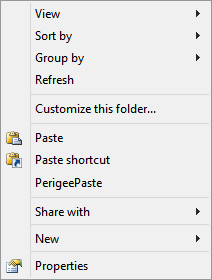 Or you can right click items and choose PerigeeDelete. You can even right click and drag selected items to show this menu with drag and drop handlers:
Or you can right click items and choose PerigeeDelete. You can even right click and drag selected items to show this menu with drag and drop handlers: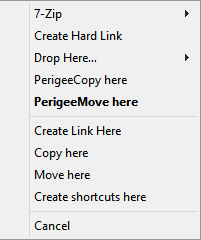 Install PerigeeCopy from this page and open the shortcut to "Configure PerigeeCopy" from the Start menu/Start screen.
Install PerigeeCopy from this page and open the shortcut to "Configure PerigeeCopy" from the Start menu/Start screen.
PerigeeCopy has got several options to configure. They are very easy to understand, still I will walk you though each one of them and their recommended setting.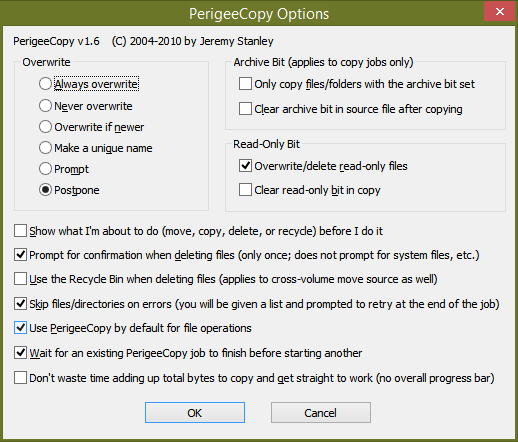
- The first set of options contains radio buttons to let you choose the overwrite method when a file collision/conflict occurs while copying files. You can choose to automatically Always overwrite, Never overwrite, Overwrite if newer, or rename the copied item (Make a unique name). If you set any of these options, it will not prompt you at all - it will straightaway do that action. Cool, isn't it?If you want to be prompted as soon as its comes across a file overwrite conflict, select Prompt. I recommend setting it to the 'Postpone' option which postpones the prompt till the end and continues copying the rest of the files, so you can walk away or multitask once you start the copy operation.
- The option "Show what I'm about to do..." confirms every action before its starts. I recommend turning this off but it's up to you to set this as per your personal choice.
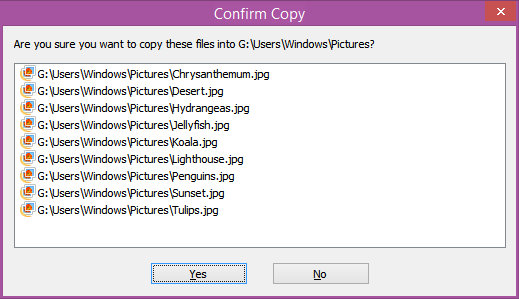
- PerigeeCopy handles delete operations as well, not just copy/move operations! The next option 'Prompt for confirmation when deleting files' deals with that. If you check it, it will confirm that you want to delete the selected files, not delete them straight away. Set this as per your preference. Note that you can only delete items using PerigeeCopy if you right click them and choose PerigeeDelete. Also, note that it only prompts you once - it doesn't you repeated warnings for read-only or system files when deleting them.
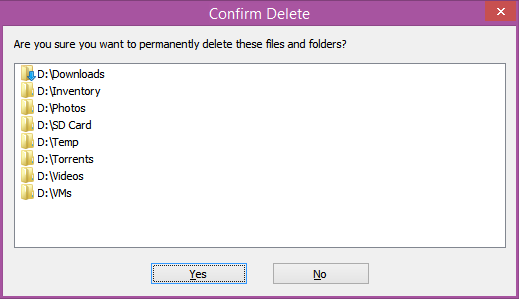
- I recommend unchecking the next option "Use the Recycle Bin when deleting files" because even if you move files and folder from one drive to another, that will be considered as a copy-and-delete operation so PerigeeCopy will send the files from the source volume to the Recycle Bin when moving them.
- The next option is very useful and should be checked: "Skip files/directories on errors". Note that these errors are not file conflicts or collisions but any general error such as if the source medium is unreadable or damaged and so the files cannot be copied or if the destination path is read-only. PerigeeCopy will try copying these files for a while and if it can't, it will skip them, and continue copying the rest. When it finishes, it will show you a list of files that could not be copied and offer to retry copying them or cancel. Neat!
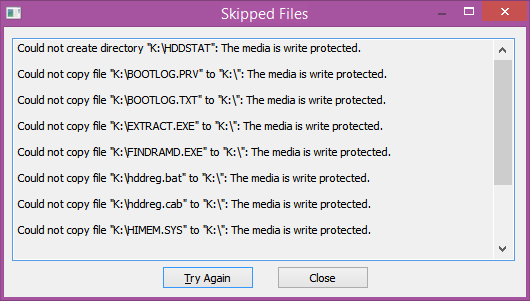
- The next option "Use PerigeeCopy by default for file operations" is to be checked if you want it to act as the default Windows copy handler, overriding the built-in Windows copy engine. Note that even if you check this, for deleting files using PerigeeCopy, you will have to right click them and choose PerigeeDelete.
- The next option is the killer feature that we've been talking about. Turning on "Wait for an existing PerigeeCopy job to finish before starting another" will make sure that another copy doesn't start if one is already running, it gets queued. However, you can force it to start any time.
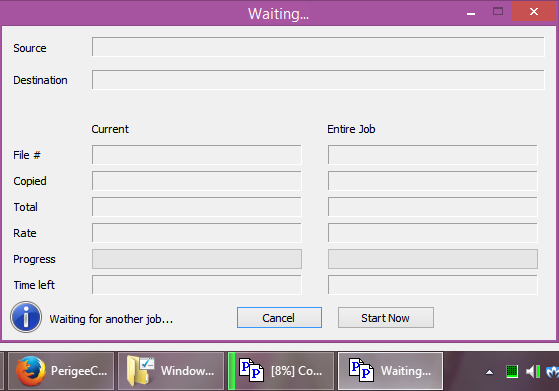
- "Don't waste time adding up total bytes to copy" prevents it from estimating how much time will be required to finish the copy job. This obviously gives you an indeterminate progress bar for the overall operation instead of showing exactly how much percentage of copying is done. Uncheck this option as PerigeeCopy is quite fast at determining this.
- The rest of the options deal with how you want to handle the 'read-only' and 'archive' file attributes while copying or deleting.
- The option 'Only copy files/folders with the archive bit set' is great for making incremental backups. When it's enabled, only those files will be copied for which you have checked "File is ready for archiving" option in Windows file properties -> Advanced Attributes.
- The option "Overwrite/delete read-only files" controls whether the read-only, hidden, and system attributes of files are cleared before they are overwritten or deleted.
The actual copying interface also uses the native Windows classic look and shows all the useful information you need: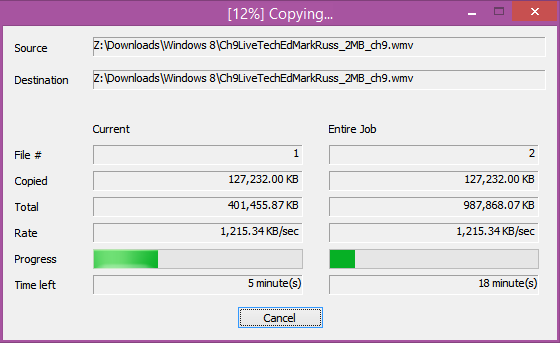 You can see the copy progress in percentage and the usual gorgeous Aero style progress bar. You can also see the source and destination paths, number of files copied, the data transferred in kilobytes, the copy speed in KB/s and the estimated time left.
You can see the copy progress in percentage and the usual gorgeous Aero style progress bar. You can also see the source and destination paths, number of files copied, the data transferred in kilobytes, the copy speed in KB/s and the estimated time left.
When a file collision/conflict occurs, PerigeeCopy shows this dialog which is very similar to the classic Windows overwrite dialog:
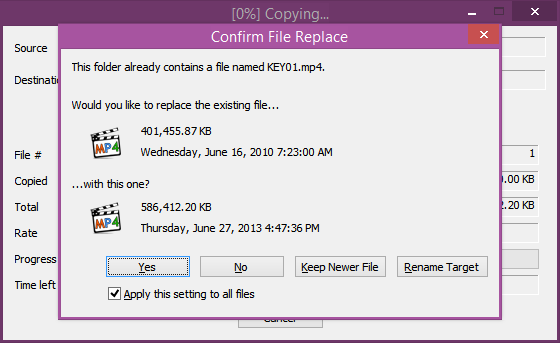 It has the standard Yes/No/Rename/Yes To All/No to All/Rename All behaviors (when "Apply this setting to all files" option is checked). Additionally, The ability to "Keep Newer File(s)" automatically by date is another killer feature.
It has the standard Yes/No/Rename/Yes To All/No to All/Rename All behaviors (when "Apply this setting to all files" option is checked). Additionally, The ability to "Keep Newer File(s)" automatically by date is another killer feature.
Closing words
One of my favorite features in Windows XP/7 was that if you copied a file into a folder that already had a file of the same name, it showed you the details right away. Windows 8 just says that there is a conflict and asks what you want to do. In order to get the information necessary to make an informed choice, you have to click on an option to "Compare info for both files" and then you get a separate "File Conflict" dialog box. 99% of the time, I want to see that information, so those extra clicks were starting to grate on me.
PerigeeCopy is a very well-designed app. It's a shame it isn't actively developed because it has the potential to be so much more. I prefer it to the Windows 8 copy because it can queue copy operations and because the conflict dialogs require fewer clicks to compare and overwrite files. PerigeeCopy is also very resilient at continuing the copy job and postponing all errors and conflicts till the end.
Support us
Winaero greatly relies on your support. You can help the site keep bringing you interesting and useful content and software by using these options:

Very good.